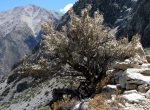 This evergreen shrub or small tree is native to dry mountain slopes of western US from Washington to California, east to Idaho, Montana, Whyoming, Colorado, Utah and northern Arizona. It is a member of the rose family, Rosaceae, that also includes cherry, almond, and lady’s mantle. The densely branched plants can grow up to 35′ tall but are usually shorter and have a spreading open crown of thick twisted branches with reddish-brown bark. The leathery lanceolate leaves are up to 1.6″ long, sticky and sometimes have rolled-under margins. They are dark green on the top, white and hairy below and are often clustered at the ends of spur-like shoots. In spring, single or small clusters of 2-3 greenish yellow flowers appear. The flowers lack petals and consist of an elongated tube formed by the sepals. The trumpet-like tube opens into 5 lobes and contains a plume-like style covered with tan hairs. The fruit is hairy and has a twisted plume-like tail. The plants are extremely drought tolerant and when pruned back hard to encourage branching make an excellent screen or hedge, especially in a xeriscape. The genus name, Cercocarpus, comes from the Greek word kerkos meaning a tail and karpos meaning a fruit and refers to conspicuous plumed fruit. The specific epithet, ledifolius, comes from the Greek word ledon, the name of the plant Labrador tea, and the Latin word meaning leaved, and refers to the resemblance of the leaf to that of Labrador tea.
This evergreen shrub or small tree is native to dry mountain slopes of western US from Washington to California, east to Idaho, Montana, Whyoming, Colorado, Utah and northern Arizona. It is a member of the rose family, Rosaceae, that also includes cherry, almond, and lady’s mantle. The densely branched plants can grow up to 35′ tall but are usually shorter and have a spreading open crown of thick twisted branches with reddish-brown bark. The leathery lanceolate leaves are up to 1.6″ long, sticky and sometimes have rolled-under margins. They are dark green on the top, white and hairy below and are often clustered at the ends of spur-like shoots. In spring, single or small clusters of 2-3 greenish yellow flowers appear. The flowers lack petals and consist of an elongated tube formed by the sepals. The trumpet-like tube opens into 5 lobes and contains a plume-like style covered with tan hairs. The fruit is hairy and has a twisted plume-like tail. The plants are extremely drought tolerant and when pruned back hard to encourage branching make an excellent screen or hedge, especially in a xeriscape. The genus name, Cercocarpus, comes from the Greek word kerkos meaning a tail and karpos meaning a fruit and refers to conspicuous plumed fruit. The specific epithet, ledifolius, comes from the Greek word ledon, the name of the plant Labrador tea, and the Latin word meaning leaved, and refers to the resemblance of the leaf to that of Labrador tea.
Type: Evergreen shrub or small tree
Outstanding Feature:
Form: Rounded or vase-shaped
Growth Rate: Slow
Bloom: Inconspicuous greenish yellow apetalous flowers with 5-lobed trumpet shaped tube formed by the sepals in spring
Size: 3-35′ x 3-35′
Light:Full sun
Soil: Average, dry, well-drained
Hardiness: Zones 3-8
Care: Can be hard pruned, even to the ground, to promote bushiness.
Pests and Diseases: None of significance
Propagation: Seed, cuttings,
Photo Credit: Wikimedia Commons